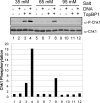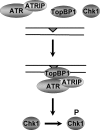Reconstitution of a human ATR-mediated checkpoint response to damaged DNA
- PMID: 17686975
- PMCID: PMC1941640
- DOI: 10.1073/pnas.0706013104
Reconstitution of a human ATR-mediated checkpoint response to damaged DNA
Abstract
The DNA damage checkpoint response delays cell cycle progression upon DNA damage and prevents genomic instability. Genetic analysis has identified sensor, mediator, signal transducer, and effector components of this global signal transduction pathway. Here we describe an in vitro system with purified human checkpoint proteins that recapitulates key elements of the DNA damage checkpoint. We show that the damage sensor ATR in the presence of topoisomerase II binding protein 1 (TopBP1) mediator/adaptor protein phosphorylates the Chk1 signal-transducing kinase in a reaction that is strongly dependent on the presence of DNA containing bulky base lesions. The dependence on damaged DNA requires DNA binding by TopBP1, and, indeed, TopBP1 shows preferential binding to damaged DNA. This in vitro system provides a useful platform for mechanistic studies of the human DNA damage checkpoint response.
Conflict of interest statement
The authors declare no conflict of interest.
Figures






Similar articles
-
Tethering DNA damage checkpoint mediator proteins topoisomerase IIbeta-binding protein 1 (TopBP1) and Claspin to DNA activates ataxia-telangiectasia mutated and RAD3-related (ATR) phosphorylation of checkpoint kinase 1 (Chk1).J Biol Chem. 2011 Jun 3;286(22):19229-36. doi: 10.1074/jbc.M111.237958. Epub 2011 Apr 18. J Biol Chem. 2011. PMID: 21502314 Free PMC article.
-
Claspin operates downstream of TopBP1 to direct ATR signaling towards Chk1 activation.Mol Cell Biol. 2006 Aug;26(16):6056-64. doi: 10.1128/MCB.00492-06. Mol Cell Biol. 2006. PMID: 16880517 Free PMC article.
-
Interaction between Rad9-Hus1-Rad1 and TopBP1 activates ATR-ATRIP and promotes TopBP1 recruitment to sites of UV-damage.DNA Repair (Amst). 2014 Sep;21:1-11. doi: 10.1016/j.dnarep.2014.05.001. Epub 2014 May 27. DNA Repair (Amst). 2014. PMID: 25091155
-
TopBP1 and DNA polymerase alpha-mediated recruitment of the 9-1-1 complex to stalled replication forks: implications for a replication restart-based mechanism for ATR checkpoint activation.Cell Cycle. 2009 Sep 15;8(18):2877-84. doi: 10.4161/cc.8.18.9485. Epub 2009 Sep 9. Cell Cycle. 2009. PMID: 19652550 Review.
-
The DNA damage response: sensing and signaling.Curr Opin Cell Biol. 2004 Dec;16(6):629-33. doi: 10.1016/j.ceb.2004.09.005. Curr Opin Cell Biol. 2004. PMID: 15530773 Review.
Cited by
-
Interactions of human mismatch repair proteins MutSalpha and MutLalpha with proteins of the ATR-Chk1 pathway.J Biol Chem. 2010 Feb 19;285(8):5974-82. doi: 10.1074/jbc.M109.076109. Epub 2009 Dec 22. J Biol Chem. 2010. PMID: 20029092 Free PMC article.
-
ATR Kinase Inhibition Protects Non-cycling Cells from the Lethal Effects of DNA Damage and Transcription Stress.J Biol Chem. 2016 Apr 22;291(17):9330-42. doi: 10.1074/jbc.M116.719740. Epub 2016 Mar 3. J Biol Chem. 2016. PMID: 26940878 Free PMC article.
-
Lagging strand maturation factor Dna2 is a component of the replication checkpoint initiation machinery.Genes Dev. 2013 Feb 1;27(3):313-21. doi: 10.1101/gad.204750.112. Epub 2013 Jan 25. Genes Dev. 2013. PMID: 23355394 Free PMC article.
-
Reconstitution of human claspin-mediated phosphorylation of Chk1 by the ATR (ataxia telangiectasia-mutated and rad3-related) checkpoint kinase.J Biol Chem. 2009 Nov 27;284(48):33107-14. doi: 10.1074/jbc.M109.064485. Epub 2009 Oct 14. J Biol Chem. 2009. PMID: 19828454 Free PMC article.
-
Multiple ATR-Chk1 pathway proteins preferentially associate with checkpoint-inducing DNA substrates.PLoS One. 2011;6(7):e22986. doi: 10.1371/journal.pone.0022986. Epub 2011 Jul 29. PLoS One. 2011. PMID: 21829571 Free PMC article.
References
-
- Abraham RT. Genes Dev. 2001;15:2177–2196. - PubMed
-
- Nyberg KA, Michelson RJ, Putnam CW, Weinert TA. Annu Rev Genet. 2002;36:617–656. - PubMed
-
- Sancar A, Lindsey-Boltz LA, Ünsal-Kaçmaz K, Linn S. Annu Rev Biochem. 2004;73:39–85. - PubMed
-
- Lee JH, Paull TT. Science. 2004;304:93–96. - PubMed
-
- Lee JH, Paull TT. Science. 2005;308:551–554. - PubMed
Publication types
MeSH terms
Substances
Grants and funding
LinkOut - more resources
Full Text Sources
Molecular Biology Databases
Research Materials
Miscellaneous

